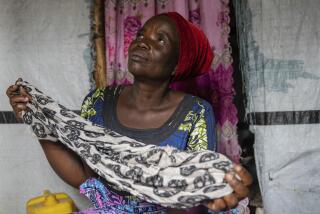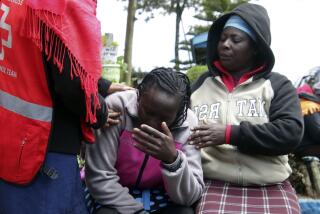Youthsâ attacks against schools shock Kenyans
NAIROBI, KENYA â In a country where education is still considered a privilege and children beg parents to attend school, Kenyans have been shocked by the latest violence to rock their East African nation: students trying to burn down their schools.
An unprecedented wave of student strikes and riots has closed about 250 high schools over the last month. There have been arson attacks at about half of them. Scores of teenagers have been arrested and thousands more sent home. One student died in a dormitory blaze.
âWe donât understand this sudden attachment to burning,â said Karega Mutahi, the Education Ministryâs permanent secretary.
Students cite poor facilities, overcrowding, abusive administrators and the schoolsâ failure to prepare them for national graduation exams.
But to many adults, the violence seems more likely the result of spoiling young people, who they say are involved in drug use, promiscuity and even devil worship. They say the turmoil is nothing that a good, hard whack with a cane canât resolve.
Their solutions include banning cellphones in schools, restricting television and calling for a reinstatement of corporal punishment. One government minister blamed âforeign ideologiesâ for a 2001 law against school caning, which was previously common.
Experts say Kenyaâs leaders seem to be looking at every conceivable explanation except the most obvious: the meltdown that killed more than 1,000 people after the disputed Dec. 27 presidential election.
âIn a sense, they are blaming children for their own bad behavior,â said Birgithe Lund-Henriksen, chief of child protection at UNICEF in Nairobi, the capital. She said itâs not surprising to see a student outburst six months after youths saw the nation nearly disintegrate into tribal bloodshed.
âThese kids saw appalling violence,â she said. âTheyâre traumatized. You try to hold it in, but it needs to come out one way or another. Now they are reflecting the behavior of the adults.â
Nairobi high school senior Moses Ngari, 17, said he has not participated in any school violence, but defended the protests.
âThis idea of taking everything to the streets has influenced us,â he said. âTeachers strike. Doctors strike. If my parent comes home and tells me he was on strike, who am I not to do it?â
Kenyan sociologist Ken Ouko said the student riots have also exposed a fracture between the countryâs older generation, which holds political and economic power, and those coming of age at a time of high inflation and unemployment.
âThe sleeping problem that no one wants to talk about is the generational divide in Kenya,â he said. âYoung people feel shortchanged.â
Mutahi said some of the rebelling students probably got their first taste of protests after the election and have been emboldened because few perpetrators of election-related attacks have been prosecuted.
âSome of these children were involved in blocking roads, tearing up railroads and burning tires, and then nothing happened to them,â Mutahi said. âSo now when they feel disgusted with something, they do the same thing. It showed young people that they have some power.â
Law enforcement officials are threatening to arrest students and try them as adults, vowing to seek life sentences for arson attacks. But Ouko said their get-tough approach offers too little, too late.
âThey are trying to lock the barn after the horses have bolted,â he said.
Many see educational reform as the best solution. Kenya is one of only a few African nations to offer free public education from grades one through 12. But due to a shortage of schools, fewer than half of grade-schoolers are able to attend high school.
As enrollment has surged, the government has failed to build new schools or hire more teachers. Schools need textbooks. Dorms lack mattresses. For those students who do attend high school, only one in 10 can find space at a university.
âWe are wasting so many young people,â said Teresa Mutegi, deputy principal at Langata High School in Nairobi.
Under Kenyaâs system, advancement is based almost entirely on results of the national graduation exam, testing four yearsâ work with no consideration for class participation or course grades and little credit for extracurricular activities.
As a result, pressure on students to score high is immense. Seniors frequently study from 6 a.m. to 10 p.m., including Saturdays and half a day on Sundays. Teachers push them hard because their performance evaluations are based largely on their studentsâ test scores.
For parents, a well-educated child is often the familyâs only hope for escaping poverty.
âItâs so stressful, sometimes I cry,â said Shenaiza Ali, 18, a senior at a Nairobi girls school. âIf I do poorly, my parents yell, âWhat are you doing?â Sometimes I feel itâs too much.â
Fear of performing poorly on a midyear practice exam scheduled this week drove the recent unrest. Many students complained that they fell behind this year after missing weeks or even months of classes because of the postelection violence. In response to the recent tension, many schools canceled the mock exams.
Kenyaâs growing emphasis on boarding schools is another factor, experts said. Even poor parents scrimp to send their children to live at cheap boarding schools. Conditions may be dismal, but boarding school students tend to test better. Parents often see children only once every three months. Experts say younger students are, in effect, being raised by older fellow students.
Sara Cameron, communications chief at UNICEF in Nairobi, termed that a â âLord of the Fliesâ situation,â referring to the novel about British schoolboys stranded on an island who degenerate into savagery.
UNICEF and others are calling for greater sensitivity to childrenâs needs, more on-campus counselors and the creation of student parliaments or advisory committees to permit students to vent frustration.
--
Special correspondent Nicholas Soi contributed to this report.
More to Read
Sign up for Essential California
The most important California stories and recommendations in your inbox every morning.
You may occasionally receive promotional content from the Los Angeles Times.










